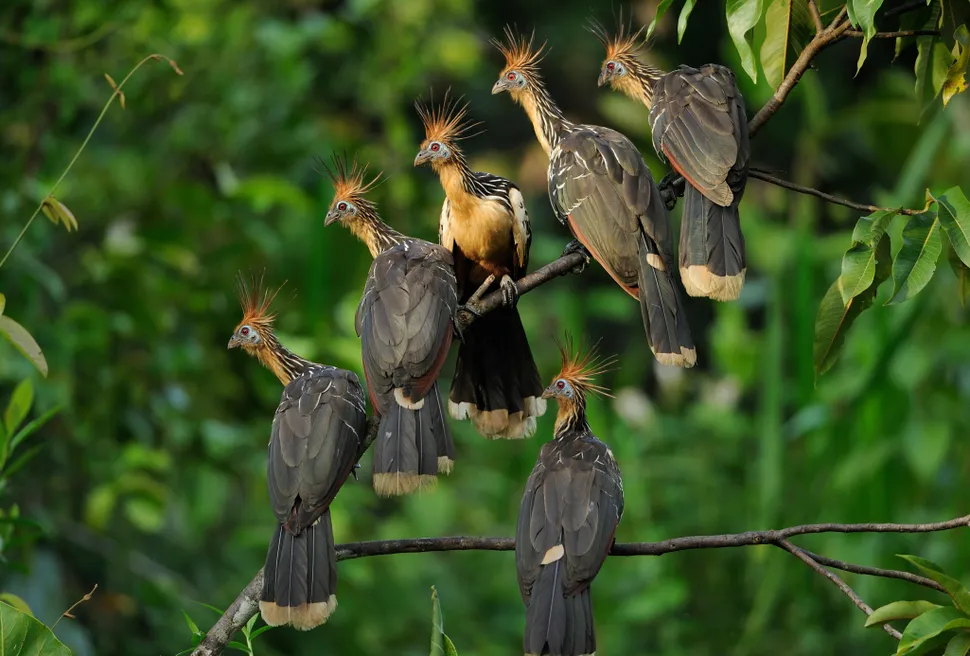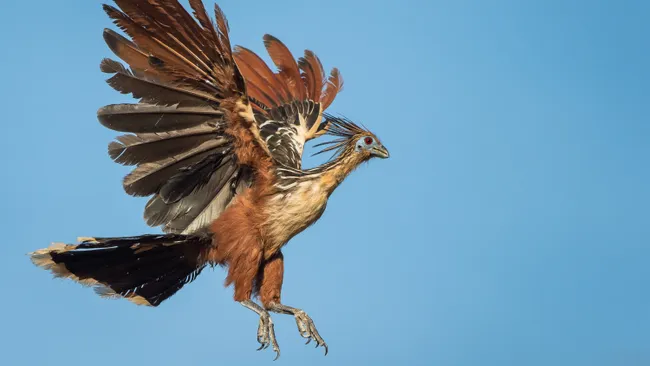Name: Hoatzin (Opisthocomus hoazin)
Where it lives: Amazon and Orinoco river basins in South America
What it eats: Leaves, fruits and flowers
Why it’s awesome: The hoatzin is often regarded as one of the world’s strangest birds. Hatchlings are born with clawed wings a rare, prehistoric trait and adults give off a strong, unpleasant smell due to their cow-like, fermenting digestive system, earning them the nickname “stinkbird.”
Hoatzin have some pretty weird traits, with mohican crests, blue facial skin, red eyes and large, fan-shaped tails, which they used to maintain balance while navigating dense vegetation.
But these tropical birds are most notable for their pungent odor, which is commonly compared to manure or rotting vegetation. This unpleasant smell is the result of a highly unusual digestive process that sets them apart from almost every other bird species.
Unlike most birds, the hoatzin has a foregut fermentation system, similar to the one found in cows. It primarily feeds on leaves, which it stores and ferments in a large, chambered crop a temporary food storage pouch located in the esophagus. Then, the food is passed to the stomach for fermentation, where bacteria break down the tough plant material, releasing gases via burps that produce the bird’s distinctive manure-like odor.

This digestive process is highly efficient for breaking down the high levels of cellulose found in leaves. But, it makes the hoatzin both smelly and clumsy, as its enlarged gut makes it difficult to fly. However, the hoatzin’s unusual smell acts as a natural defence mechanism, as predators tend to avoid the bird because they think it is rotten or poisonous.
Researchers are uncertain about the evolution of hoatzins. In 2015, a genetic study in the journal Nature suggested that the hoatzin is the last surviving member of a bird line that branched off the evolutionary tree in its own direction 64 million years ago, shortly after the extinction event that wiped out the non-avian dinosaurs.
However, a separate 2024 study in PNAS suggested that hoatzins are not as ancient as previously thought. Although the wing claws of juveniles seem prehistoric, they may have evolved more recently to help these birds survive in the Amazon jungle. As young hoatzins can’t fly, their claws allow them to climb trees to escape predators.
In 2024, biologists analyzed and mapped the genomes of more than 360 bird species to create a family tree of major bird groups, but where hoatzin fit into the picture is unclear. The researchers added hoatzins to a category called “orphans” along with shorebirds and cranes because it’s unclear where hoatzins sit within the avian family tree.
This bird is also the national bird of Guyana, where the local name for this bird is Canje pheasant.
Download a photo of this bird
Download(2)




0 Comments